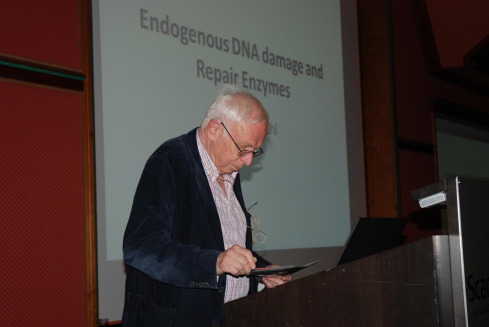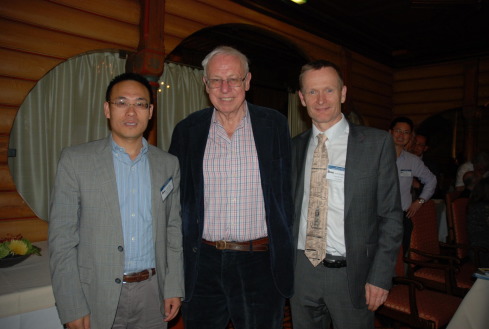Abstract
Tomas Lindahl completed his medical studies at Karolinska Institute in 1970. Yet, his work has always been dedicated to unraveling fundamental mechanisms of DNA decay and DNA repair. His research is characterized with groundbreaking discoveries on the instability of our genome, the identification of novel DNA repair activities, the characterization of DNA repair pathways, and the association to diseases, throughout his 40 years of scientific career.
DNA is the genetic material that transmits all genetic information to the offspring and to do this faithfully, DNA was for long presumed to be absolutely stable. This hypothesis was challenged by the early study of Lindahl—Rate of depurination of native DNA[1] . He also identified numerous endogenous sources of DNA damage [2] , [3] and [4] . The number of DNA damages in a single human cell exceeds 10,000 every day and must be counteracted by special DNA repair processes. Tomas Lindahl summarized crucial knowledge on endogenous DNA damage and repair in an important review in 1993—Instability and decay of the primary structure of DNA[5] . This review also communicated fundamental knowledge on the stability of DNA to a broad audience.
Base excision repair is the repair pathway that handles most of the spontaneous lesions to our genome, such as abasic site (AP site), uracil, and various alkylated- or oxidized-DNA bases. Tomas Lindahl identified a New class of enzymes acting on damaged DNA , including uracil [6] and [7] , the DNA glycosylases. He further characterized DNA glycosylases specific for numerous damaged bases including methylated [8] and oxidized bases [9] . Furthermore, he described in detail the single-nucleotide repair patches generated following repair of uracil [10] and went on to identify all enzymes required for complete base excision repair on naked DNA and on nucleosomes [11] , [12] , [13] and [14] .
An even more sophisticated strategy for DNA repair, the adaptive response to alkylating agents, was characterized in a series of ground-breaking studies. First, he identified the methylated guanine required for the adaptive response [15] and later identified the intracellular signal [16] and the ada gene product with two unique functions in the induction of alkylation resistance [17] . Tomas Lindahl’s group was also the key to the identification and characterization of the AlkB family of dioxygenases [18] , [19] and [20] . The AlkB repair mechanism was later shown to have fundamental importance for histone demethylation, 5-methylC hydroxylation, and reversible RNA methylation.
The list of enzymes, including various DNA glycosylases, alkyltransferases, endo- and exonucleases identified and characterized by Tomas Lindahl’s group for various aspects of DNA metabolisms is nearly endless. Some examples are early studies on uracil [21] , hypoxanthine [22] , processing of DNA 5′ terminal ends [23] , poly(ADP-ribose) [24] , and the DNA ligases that complete various repair pathways by sealing nicks in DNA [26] and [27] , as well as more recent studies on Trex1-mediated degradation of single-stranded (ssDNA) [25] . Several mammalian repair enzymes were further characterized by the design of gene-targeted mice [28] , [29] , [30] and [31] .
It is probably less known that Tomas Lindahl, early in his scientific life, also did ground-breaking studies on the genome of the Epstein–Barr virus (EBV). Of major interest was his initial characterization of the circular EBV genome [32] . This study was followed up with a series of important publications of the EBV DNA in cancer cell lines (e.g. , [33] ) and also included the identification of sequence variants of the Epstein–Barr genome [34] .
Tomas Lindahl started his scientific career at Karolinska Institute, where he completed his PhD in 1967. He did his postdoctoral training at the Princeton University and the Rockefeller University and then became a professor at the University of Gothenburg in 1978. He is world-wide renowned also for directing the Clare Hall laboratories, part of Cancer Research UK that became a wonderful place to work and a leading center for studies on DNA repair and related processes.
On a more personal note; one, out of many, remarkable experiences working as postdocs in Tomas Lindahl’s group at Clare Hall, was his daily walks through his laboratory asking everybody “how is it going”, which could lead to a short answer or a one-hour scientific discussion. This guidance has continued for years after completing our postdoctoral training at Clare Hall, for which we are truly grateful.
Tomas Lindahl gave a keynote presentation at the “Tomas Lindahl Conference on DNA Repair” (Figure 1 ), organized by his two former postdocs Drs. Yun-Gui Yang and Arne Klungland in Oslo on June 20, 2015 (Figure 2 ).
|
|
|
Figure 1. Keynote presentation by Tomas Lindahl at the “Tomas Lindahl Conference on DNA Repair”, Holmenkollen, Oslo, 2015 |
|
|
|
Figure 2. Yun-Gui Yang (left) and Arne Klungland (right) with Tomas Lindahl at the “Tomas Lindahl Conference on DNA Repair”, Holmenkollen, Oslo, 2015 |
References
- [1] T. Lindahl, B. Nyberg; Rate of depurination of native deoxyribonucleic acid; Biochemistry, 11 (1972), pp. 3610–3618
- [2] P. Karran, T. Lindahl; Hypoxanthine in deoxyribonucleic acid: generation by heat-induced hydrolysis of adenine residues and release in free form by a deoxyribonucleic acid glycosylase from calf thymus; Biochemistry, 19 (1980), pp. 6005–6011
- [3] B. Rydberg, T. Lindahl; Nonenzymatic methylation of DNA by the intracellular methyl group donor S-adenosyl-l -methionine is a potentially mutagenic reaction ; EMBO J, 1 (1982), pp. 211–216
- [4] L.H. Breimer, T. Lindahl; Thymine lesions produced by ionizing radiation in double-stranded DNA; Biochemistry, 24 (1985), pp. 4018–4022
- [5] T. Lindahl; Instability and decay of the primary structure of DNA; Nature, 362 (1993), pp. 709–715
- [6] T. Lindahl; New class of enzymes acting on damaged DNA; Nature, 259 (1976), pp. 64–66
- [7] T. Lindahl; An N -glycosidase from Escherichia coli that releases free uracil from DNA containing deaminated cytosine residues ; Proc Natl Acad Sci U S A, 71 (1974), pp. 3649–3653
- [8] C.J. Chetsanga, T. Lindahl; Release of 7-methylguanine residues whose imidazole rings have been opened from damaged DNA by a DNA glycosylase from Escherichia coli; Nucleic Acids Res, 6 (1979), pp. 3673–3684
- [9] T. Roldán-Arjona, Y.F. Wei, K.C. Carter, A. Klungland, C. Anselmino, R.P. Wang; Molecular cloning and functional expression of a human cDNA encoding the antimutator enzyme 8-hydroxyguanine-DNA glycosylase; Proc Natl Acad Sci U S A, 94 (1997), pp. 8016–8020
- [10] G. Dianov, A. Price, T. Lindahl; Generation of single-nucleotide repair patches following excision of uracil residues from DNA; Mol Cell Biol, 12 (1992), pp. 1605–1612
- [11] G. Dianov, T. Lindahl; Reconstitution of the DNA base excision-repair pathway; Curr Biol, 4 (1994), pp. 1069–1076
- [12] Y. Kubota, R.A. Nash, A. Klungland, P. Schar, D.E. Barnes, T. Lindahl; Reconstitution of DNA base excision-repair with purified human proteins: interaction between DNA polymerase beta and the XRCC1 protein; EMBO J, 15 (1996), pp. 6662–6670
- [13] A. Klungland, T. Lindahl; Second pathway for completion of human DNA base excision-repair: reconstitution with purified proteins and requirement for DNase IV (FEN1); EMBO J, 16 (1997), pp. 3341–3348
- [14] H. Nilsen, K.A. Haushalter, P. Robins, D.E. Barnes, G.L. Verdine, T. Lindahl; Excision of deaminated cytosine from the vertebrate genome: role of the SMUG1 uracil-DNA glycosylase; EMBO J, 20 (2001), pp. 4278–4286
- [15] P. Karran, T. Lindahl, B. Griffin; Adaptive response to alkylating agents involves alteration in situ of O6 -methylguanine residues in DNA ; Nature, 280 (1979), pp. 76–77
- [16] I. Teo, B. Sedgwick, M.W. Kilpatrick, T.V. McCarthy, T. Lindahl; The intracellular signal for induction of resistance to alkylating agents in E. coli; Cell, 45 (1986), pp. 315–324
- [17] I. Teo, B. Sedgwick, B. Demple, B. Li, T. Lindahl; Induction of resistance to alkylating agents in E. coli : the ada + gene product serves both as a regulatory protein and as an enzyme for repair of mutagenic damage ; EMBO J, 3 (1984), pp. 2151–2157
- [18] S.C. Trewick, T.F. Henshaw, R.P. Hausinger, T. Lindahl, B. Sedgwick; Oxidative demethylation by Escherichia coli AlkB directly reverts DNA base damage ; Nature, 419 (2002), pp. 174–178
- [19] T. Duncan, S.C. Trewick, P. Koivisto, P.A. Bates, T. Lindahl, B. Sedgwick; Reversal of DNA alkylation damage by two human dioxygenases; Proc Natl Acad Sci U S A, 99 (2002), pp. 16660–16665
- [20] S. Dinglay, S.C. Trewick, T. Lindahl, B. Sedgwick; Defective processing of methylated single-stranded DNA by E. coli AlkB mutants ; Genes Dev, 14 (2000), pp. 2097–2105
- [21] T. Lindahl, S. Ljungquist, W. Siegert, B. Nyberg, B. Sperens; DNA N-glycosidases: properties of uracil-DNA glycosidase from Escherichia coli; J Biol Chem, 252 (1977), pp. 3286–3294
- [22] P. Karran, T. Lindahl; Enzymatic excision of free hypoxanthine from polydeoxynucleotides and DNA containing deoxyinosine monophosphate residues; J Biol Chem, 253 (1978), pp. 5877–5879
- [23] T. Lindahl, J.A. Gally, G.M. Edelman; Deoxyribonuclease IV: a new exonuclease from mammalian tissues; Proc Natl Acad Sci U S A, 62 (1969), pp. 597–603
- [24] M.S. Satoh, T. Lindahl; Role of poly (ADP-ribose) formation in DNA repair; Nature, 356 (1992), pp. 356–358
- [25] Y.G. Yang, T. Lindahl, D.E. Barnes; Trex1 exonuclease degrades ssDNA to prevent chronic checkpoint activation and autoimmune disease; Cell, 131 (2007), pp. 873–886
- [26] D.E. Barnes, L.H. Johnston, K. Kodama, A.E. Tomkinson, D.D. Lasko, T. Lindahl; Human DNA ligase I cDNA: cloning and functional expression in Saccharomyces cerevisiae; Proc Natl Acad Sci U S A, 87 (1990), pp. 6679–6683
- [27] A.E. Tomkinson, E. Roberts, G. Daly, N.F. Totty, T. Lindahl; Three distinct DNA ligases in mammalian cells; J Biol Chem, 266 (1991), pp. 21728–21735
- [28] D.E. Barnes, G. Stamp, I. Rosewell, A. Denzel, T. Lindahl; Targeted disruption of the gene encoding DNA ligase IV leads to lethality in embryonic mice; Curr Biol, 8 (1998), pp. 1395–1398
- [29] H. Nilsen, I. Rosewell, P. Robins, C.F. Skjelbred, S. Andersen, G. Slupphaug; Uracil-DNA glycosylase (UNG)-deficient mice reveal a primary role of the enzyme during DNA replication; Mol Cell, 5 (2000), pp. 1059–1065
- [30] M. Morita, G. Stamp, P. Robins, A. Dulic, I. Rosewell, G. Hrivnak; Gene-targeted mice lacking the Trex1 (DNase III) 3′ → 5′ DNA exonuclease develop inflammatory myocarditis; Mol Cell Biol, 24 (2004), pp. 6719–6727
- [31] A. Klungland, I. Rosewell, S. Hollenbach, E. Larsen, G. Daly, B. Epe, et al.; Accumulation of premutagenic DNA lesions in mice defective in removal of oxidative base damage; Proc Natl Acad Sci U S A, 96 (1999), pp. 13300–13305
- [32] A. Adams, T. Lindahl; Epstein–Barr virus genomes with properties of circular DNA molecules in carrier cells; Proc Natl Acad Sci U S A, 72 (1975), pp. 1477–1481
- [33] C. Kaschka-Dierich, A. Adams, T. Lindahl, G.W. Bornkamm, G. Bjursell, G. Klein; Intracellular forms of Epstein–Barr virus DNA in human tumour cells in vivo; Nature, 260 (1976), pp. 302–306
- [34] L. Rymo, T. Lindahl, A. Adams; Sites of sequence variability in Epstein–Barr virus DNA from different sources; Proc Natl Acad Sci U S A, 76 (1979), pp. 2794–2798
Document information
Published on 20/10/16
Licence: Other
Share this document
claim authorship
Are you one of the authors of this document?

